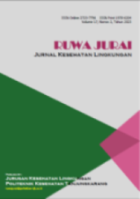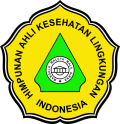Efek Kombinasi Tanaman Dengan Variasi Konsentrasi Terhadap Mortalitas Larva Culexsp. (Diptera: Culicidae)
DOI:
https://doi.org/10.26630/rj.v18i1.4455Keywords:
A. muricata, A. bilimbi, Bio-larvasida, Culex sp, P. guajavaAbstract
Insektisida nabati menjadi pilihan terbaik untuk mengendalikan nyamuk vektor penyakit, setelah pemahaman dampak negatif dari penggunaan insektisida kimia sintetis jangka panjang. Penelitian bertujuan mengevaluasi efek larvasida dari kombinasi empat jenis tanaman terhadap Culex sp. Penelitian menggunakan rancang acak lengkap faktorial (dengan dua ulangan), dilakukan selama bulan Maret – Juli 2023. Empat jenis tanaman (Catharanthus roseus, Annona muricata, Psidium guajava, dan Averrhoa bilimbi) dikombinasikan berpasangan dengan variasi konsentrasi campuran bertingkat, dan diamati selama 24 jam. Ekstraksi tanaman dengan maserasi menggunakan Ethanol (24jam), dievaporasi hingga pekat, dan diencerkan dengan akuades untuk konsentrasi diinginkan. Larva Culex sp. dipelihara dari fase telur hingga turunan pertama (F1). Dua puluh larva instar-III digunakan pada setiap pengujian, dengan kontrol. Data dianalisis dengan ANOVA two-way (Confidence Level= 95%). Hasil penelitian mendapatkan bahwa tiga dari empat tanaman memberikan efek mortalitas (5-20%) sejak satu jam setelah paparan, yaitu A. muricata, P. guajava, dan C. roseus. Setelah enam jam paparan, A. muricata dan P. guajava memberikan efek mortalitas tertinggi (70%). Setelah 24 jam paparan, seluruh larva mengalami kematian pada semua perlakuan. Hasil analisis statistik menunjukkan perbedaan mortalitas larva berdasarkan waktu paparan (P = 0,0001), namun tidak signifikan berdasarkan jenis tanaman (P = 0,084) dan konsentrasi campuran (P = 0,858). Dari empat yang diperiksa, dua jenis tumbuhan menunjukkan efek larvasida terbaik terhadap Culex sp., yaitu A. muricata dan P. guajava. Walaupun menunjukkan hasil yang menjanjikan, penggunaan konsentrasi tinggi masih menjadi kendala untuk diaplikasikan secara luas. Rekayasa senyawa bioaktif disarankan untuk meningkatkan aktivitas dan menurunkan konsentrasi larvasida.
References
Ahdiyah, I., & Purwani, I. I. (2015). Pengaruh Ekstrak Daun Mangkokan (Nathopanax scutellarium) Sebagai Larvasida Nyamuk Culex sp. Jurnal Sains Dan Seni ITS, 4(2), 33–36. https://doi.org/http://dx.doi.org/10.12962/j23373520.v4i2.10804
Ahmad, A., & Adriyanto, A. (2019). Efektivitas Serbuk Biji Pepaya (Carica papaya L.) Terhadap Kematian Jentik (Larva) Culex sp. Jurnal Medikes (Media Informasi Kesehatan), 6(1), 104–112. https://doi.org/10.36743/medikes.v6i1.186
Ahyanti, M., & Yushananta, P. (2022). Kombinasi Ekstrak Daun Tapak Dara (Catharanthus roseus) dan Daun Sirsak (Annona muricata) Sebagai Bio-Larvasida. Ruwa Jurai: Jurnal Kesehatan Lingkungan, 16(3), 113. https://doi.org/10.26630/rj.v16i3.3611
Ahyanti, M., & Yushananta, P. (2023a). Kandungan Saponin dan Flavonoid Pada Tanaman Pekarangan Serta Potensinya Sebagai Bioinsektisida Lalat Rumah (Musca domestica). Ruwa Jurai: Jurnal Kesehatan Lingkungan, 17(1), 31. https://doi.org/10.26630/rj.v17i1.3763
Ahyanti, M., & Yushananta, P. (2023b). Formulation, Dosage, and Exposure Time of Natural Substances in Controlling Aedes aegypti Larvae. Poltekita : Jurnal Ilmu Kesehatan, 17(3), 783–791. https://doi.org/10.33860/jik.v17i3.3353
Ahyanti, M., Yushananta, P., & Usman, S. (2023). Potential of Some Plants as Bioinsecticides of the House Fly (Musca domestica). The 1st UMSurabaya Multidisciplinary International Conference 2021 (MICon 2021), 1020–1026. https://doi.org/10.2991/978-2-38476-022-0_113
Amutha, V., Deepak, P., Kamaraj, C., Balasubramani, G., Aiswarya, D., Arul, D., Santhanam, P., Ballamurugan, A. M., & Perumal, P. (2019). Mosquito-Larvicidal Potential of Metal and Oxide nanoparticles Synthesized from Aqueous Extract of the Seagrass, Cymodocea serrulata. Journal of Cluster Science, 30(3), 797–812. https://doi.org/10.1007/s10876-019-01542-7
Benelli, G., & Beier, J. C. (2017). Current vector control challenges in the fight against malaria. Acta Tropica, 174, 91–96. https://doi.org/10.1016/j.actatropica.2017.06.028
Bilal, H., Sahar, S., & Din, S. (2017). Bio-Pesticides: New Tool for the Control of Aedes (Stegomyia) albopictus (Culicidae: Diptera) in Pakistan. Journal of Arthropod-Borne Diseases, 11(2), 278–285. http://www.ncbi.nlm.nih.gov/pubmed/29062852
Chaieb, I. (2017). Saponins as Insecticides : A Review. Journal of Plant. Protection, 5(1), 39–50. http://www.tjpp.tn/SiteWeb/PreviousIssues/TJPP5-1/4Ikbal.pdf
Duguma, D., Ortiz, S. L., Lin, Y., Wilson, P. C., & Walton, W. E. (2017). Effects of a larval mosquito biopesticide and Culex larvae on a freshwater nanophytoplankton (Selenastrum capricornatum) under axenic conditions. Journal of Vector Ecology, 42(1), 51–59. https://doi.org/10.1111/jvec.12239
Floore, T. G. (2006). Mosquito larval control practices: Past and present. Journal of the American Mosquito Control Association, 22(3), 527–533. https://doi.org/10.2987/8756-971X(2006)22[527:MLCPPA]2.0.CO;2
Govindarajan, M., Rajeswary, M., & Benelli, G. (2016). Chemical composition, toxicity and non-target effects of Pinus kesiya essential oil: An eco-friendly and novel larvicide against malaria, dengue and lymphatic filariasis mosquito vectors. Ecotoxicology and Environmental Safety, 129, 85–90. https://doi.org/10.1016/j.ecoenv.2016.03.007
Harbach, R. E. (1985). Pictorial keys to the genera of mosquitoes, subgenera of Culex and the species of Culex (Culex) occurring in southwestern Asia and Egypt, with a note on the subgeneric placement of Culex deserticola (Diptera: Culicidae). Mosquito Systematics, 17(2), 83–107. https://www.biodiversitylibrary.org/content/part/JAMCA/MS_V17_N2_P083-107.pdf
Hidayati, L., & Suprihatini, S. (2020). Pengaruh Pemberian Ekstrak Biji Mahoni (Swietenia mahagoni) Terhadap Kematian Larva Culex sp. ASPIRATOR - Journal of Vector-Borne Disease Studies, 12(1), 45–52. https://doi.org/10.22435/asp.v12i1.2171
Juariah, S., & Irawan, M. P. (2017). Biolarvasida Ekstrak Etanol Kulit Nanas (Ananans comosus L. Merr) Terhadap Larva Nyamuk Culex sp. Unnes Journal of Public Health, 6(4), 232–236. https://doi.org/10.15294/ujph.v6i4.15842
Kamatchi, P. A. C., Maheswaran, R., Sivanandhan, S., Ignacimuthu, S., Balakrishna, K., Reegan, A. D., & Arivoli, S. (2023). Bioefficacy of ursolic acid and its derivatives isolated from Catharanthus roseus (L) G. Don leaf against Aedes aegypti, Culex quinquefasciatus, and Anopheles stephensi larvae. Environmental Science and Pollution Research, 30(26), 69321–69329. https://doi.org/10.1007/s11356-023-27253-1
Kamran, M., Shad, S. A., Binyameen, M., Abbas, N., Anees, M., Shah, R. M., & Hafez, A. M. (2022). Toxicities and Cross-Resistance of Imidacloprid, Acetamiprid, Emamectin Benzoate, Spirotetramat, and Indoxacarb in Field Populations of Culex quinquefasciatus (Diptera: Culicidae). Insects, 13(9), 830. https://doi.org/https://doi.org/10.3390/insects13090830
Kartini, & Sofia. (2022). Effects of Guva Leaf Extract (Psidium Guajava) Against the Killness of Aedes aegypti Larvae. Science Midwifery, 20(2), 980–986.
Kauffman, E., Payne, A., Franke, M., Schmid, M., Harris, E., & Kramer, L. (2017). Rearing of Culex spp. and Aedes spp. Mosquitoes. Bio-Protocol, 7(17). https://doi.org/10.21769/BioProtoc.2542
Kewa, M. M., Almet, J., & Laut, M. M. (2020). Median Lethal Concentration (LC50) Ekstrak Daun Sirsak (Annona muricata Linn) Terhadap Larva Culex sp di Kota Kupang. Jurnal Kajian Veteriner, 8(2), 147–152. https://doi.org/10.35508/jkv.v8i2.3078
Khan, H. A. A. (2022). An impact assessment of insecticides application on the non-targeted mosquito Aedes albopictus (Skuse) in Punjab rice fields, Pakistan. PeerJ, 10, e13697. https://doi.org/10.7717/peerj.13697
Kumar, D., Kumar, P., Singh, H., & Agrawal, V. (2020). Biocontrol of mosquito vectors through herbal-derived silver nanoparticles: prospects and challenges. Environmental Science and Pollution Research, 27(21), 25987–26024. https://doi.org/10.1007/s11356-020-08444-6
Kusnatin, L., Soendjoto, M. A., Indrayatie, E. R., & Rohman, T. (2012). Konsentrasi dan Waktu Pendedahan Efektif Ekstrak Daun Sirsak (Annona Muricata L) Sebagai Larvasida Hayati Jentik Aedes aegypti. EnviroScienteae, 8(3), 127–134. https://doi.org/http://dx.doi.org/10.20527/es.v8i3.2078
Markus, Y. E. D. P., S.M.J.Koamesah, & Trisno, I. (2019). Efektivitas Ekstrak Biji Kelor (Moringa oleifera) Terhadap Larva Aedes aegypti dan Culex sp. Instar III/IV. Cendana Medical Journal, 7(2), 223–229. https://doi.org/https://doi.org/10.35508/cmj.v7i2.1793
Mittal, P. K., & Subbarao, S. K. (2003). Prospects of using herbal products in the control of mosquito vector. ICMR Bulletin, 33, 1–10. https://main.icmr.nic.in/sites/default/files/icmr_bulletins/bujanuary03.pdf
Nasution, A. N., & Ulina, Y. Y. (2022). Toxicity Test of The Crown of God Stemps (Phaleria macrocarpa (Scheff.) Boerl.) Against Culex sp. Larvae. Jambura Journal of Health Sciences and Research, 4(2), 587–595. https://doi.org/10.35971/jjhsr.v4i2.13943
Ntoumba, A. A., Meva, F. E., Ekoko, W. E., Foko, L. P. K., Hondt, E. N., Schlüsener, C., Moll, B., Loe, G. E., Kedi, P. B. E., Fouda, J. Y. S., Janiak, C., & Lehman, L. G. (2020). Biogenic Synthesis of Silver Nanoparticles Using Guava (Psidium guajava) Leaf Extract and Its Larvicidal Action against Anopheles gambiae. Journal of Biomaterials and Nanobiotechnology, 11(01), 49–66. https://doi.org/10.4236/jbnb.2020.111004
Pavela, R., Maggi, F., Iannarelli, R., & Benelli, G. (2019). Plant extracts for developing mosquito larvicides: From laboratory to the field, with insights on the modes of action. Acta Tropica, 193, 236–271. https://doi.org/10.1016/j.actatropica.2019.01.019
Pavunraj, M., Veluchamy, R., Shanmugavel, S., Velayutham, V., & Sundaram, J. (2017). Larvicidal and Enzyme Inhibitory Effects of Acalypha fruticosa (F.) and Catharanthus roseus L (G) Don. Leaf Extracts Against Culex Quinquefasciatus (Say.) (Diptera: Culicidae). Asian Journal of Pharmaceutical and Clinical Research, 10(3), 213. https://doi.org/10.22159/ajpcr.2017.v10i3.16029
Pratama, S. D., & Yushananta, P. (2021). Efektivitas Ekstrak Kulit Batang Maja (Aegle marmelos L.) Terhadap Kematian Larva Nyamuk Anopheles sp. Ruwa Jurai: Jurnal Kesehatan Lingkungan, 15(2), 67. https://doi.org/10.26630/rj.v15i2.2813
Putri, I. N. A., & Yushananta, P. (2022). Efektivitas Ekstrak Daun Pandan Wangi (Pandanus amaryllifolius) Sebagai Biolarvasida Terhadap Larva Culex sp. Ruwa Jurai: Jurnal Kesehatan Lingkungan, 15(3), 109. https://doi.org/10.26630/rj.v15i3.3067
Rodrigues, A., Martins, V. E., & Morais, S. (2020). Larvicidal efficacy of plant extracts and isolated compounds from Annonaceae and Piperaceae against Aedes aegypti and Aedes albopictus. Asian Pacific Journal of Tropical Medicine, 13(9), 384. https://doi.org/10.4103/1995-7645.290583
Rodrigues, Silva, Pinto, Lima dos Santos, Carneiro de Freitas, Martins, & Maia de Morais. (2019). Larvicidal and Enzymatic Inhibition Effects of Annona muricata Seed Extract and Main Constituent Annonacin against Aedes aegypti and Aedes albopictus (Diptera: Culicidae). Pharmaceuticals, 12(3), 112. https://doi.org/10.3390/ph12030112
Rohmah, E. A., Subekti, S., & Rudyanto, M. (2020). Larvicidal Activity and Histopathological Effect of Averrhoa bilimbi Fruit Extract on Aedes aegypti from Surabaya, Indonesia. Journal of Parasitology Research, 2020, 1–5. https://doi.org/10.1155/2020/8866373
Rwang PG, Effoim, O., Mercy, K., & Etokakpan, A. (2016). Effects of Psidium guajava (Guava) Extracts on Immature Stage of Mosquito. International Journal of Complementary & Alternative Medicine, 4(5). https://doi.org/10.15406/ijcam.2016.04.00132
Santhosh, S. B., Yuvarajan, R., & Natarajan, D. (2015). Annona muricata leaf extract-mediated silver nanoparticles synthesis and its larvicidal potential against dengue, malaria and filariasis vector. Parasitology Research, 114(8), 3087–3096. https://doi.org/10.1007/s00436-015-4511-2
Schlechtriem, C., Fliedner, A., & Schäfers, C. (2012). Determination of lipid content in fish samples from bioaccumulation studies: contributions to the revision of guideline OECD 305. Environmental Sciences Europe, 24(1), 13. https://doi.org/10.1186/2190-4715-24-13
Senthil-Nathan, S. (2020). A Review of Resistance Mechanisms of Synthetic Insecticides and Botanicals, Phytochemicals, and Essential Oils as Alternative Larvicidal Agents Against Mosquitoes. Frontiers in Physiology, 10. https://doi.org/10.3389/fphys.2019.01591
Silalahi, C. N., Tu, W.-C., Chang, N.-T., Singham, G. V., Ahmad, I., & Neoh, K.-B. (2022). Insecticide Resistance Profiles and Synergism of Field Aedes aegypti from Indonesia. PLOS Neglected Tropical Diseases, 16(6), e0010501. https://doi.org/10.1371/journal.pntd.0010501
Smith, L. B., Kasai, S., & Scott, J. G. (2016). Pyrethroid resistance in Aedes aegypti and Aedes albopictus: Important mosquito vectors of human diseases. Pesticide Biochemistry and Physiology, 133, 1–12. https://doi.org/10.1016/j.pestbp.2016.03.005
Supenah, P. (2018). Uji Efektivitas Sari Daun Tapak Dara (Catharanthus roseus) Sebagai Larvasida Alami Nyamuk Aedes aegypti Instar III. JAKA: Jurnal Analis Kesehatan, 1(1). https://ejournal.aakannasher.ac.id/index.php/aak/article/view/4
WHO. (2005). Guidelines for laboratory and field testing of mosquito larvicides. In World Health Organization. WHO/CDS/WHOPES/GCDPP. http://whqlibdoc.who.int/hq/2005/WHO_CDS_WHOPES_GCDPP_2005.13.pdf?ua=1
WHO. (2020). Vector-borne diseases. World Health Organization. https://www.who.int/news-room/fact-sheets/detail/vector-borne-diseases
WHO. (2023). Lymphatic filariasis. World Health Organization. https://www.who.int/news-room/fact-sheets/detail/lymphatic-filariasis
Widyastuti, D. A., Rahayu, P., & Dewi, L. R. (2019). Potensi Ekstrak Sirsak (Annona muricata) sebagai Larvasida Pengendali Populasi Aedes albopictus. Bioeksperimen: Jurnal Penelitian Biologi, 5(1), 48–54. https://doi.org/10.23917/bioeksperimen.v5i1.7991
Yushananta, P. (2021). Dengue Hemorrhagic Fever and Its Correlation with The Weather Factor In Bandar Lampung City: Study From 2009-2018. Jurnal Aisyah : Jurnal Ilmu Kesehatan, 6(1), 117–126. https://doi.org/10.30604/jika.v6i1.452
Yushananta, P., & Ahyanti, M. (2021). The Effectiveness of Betle Leaf (Piper betle L.) Extract as a Bio- pesticide for Controlled of Houseflies (Musca domestica L.). Open Access Macedonian Journal of Medical Sciences, 9(E), 895–900. https://doi.org/10.3889/oamjms.2021.6886
Downloads
Published
How to Cite
Issue
Section
License
Copyright (c) 2024 Ruwa Jurai: Jurnal Kesehatan Lingkungan

This work is licensed under a Creative Commons Attribution-NonCommercial 4.0 International License.

Ruwa Jurai: Jurnal Kesehatan Lingkungan is licensed under a Creative Commons Attribution-NonCommercial 4.0 International License.
Authors who publish with this journal agree to the following terms:
- Authors retain copyright and grant the journal right of first publication with the work simultaneously licensed under a Creative Commons Attribution-Non Commercial License that allows others to share the work with an acknowledgment of the work's authorship and initial publication in this journal.
- Authors are able to enter into separate, additional contractual arrangements for the non-exclusive distribution of the journal's published version of the work (e.g., post it to an institutional repository or publish it in a book), with an acknowledgment of its initial publication in this journal.
- Authors are permitted and encouraged to post their work online (e.g., in institutional repositories or on their website) prior to and during the submission process, as it can lead to productive exchanges, as well as earlier and greater citation of published work.









